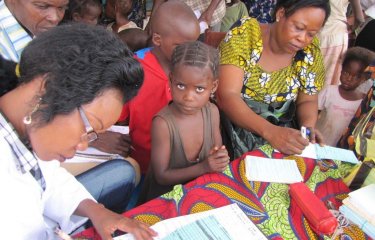Hepatitis B is a viral infection that can be fatal. Most chronic forms are caused by mother-to-child transmission. To avoid this transmission, the World Health Organization (WHO) decided to add new recommendations to its existing guidelines. Yusuke Shimakawa, an expert at the Institut Pasteur in Paris, was given the task of producing two systematic reviews to help determine the nature of the new recommendations. He coordinated this research, with the help of WHO, by forming a team including two other Institut Pasteur scientists (Anna L. Funk and Pauline Boucheron) and colleagues in China and Japan..
Hepatitis B, a major threat to global health
Hepatitis B is a viral infection that can be acute or chronic (see the Institut Pasteur's fact sheet about viral hepatitis). It is responsible for huge numbers of deaths, especially in Sub-Saharan Africa. WHO estimates that in 2015, 257 million people were living with the disease, and 900,000 people died from cirrhosis or hepatocellular carcinoma (liver cancer) related to chronic hepatitis B (HBV) infection. Most chronic carriers of HBV with liver disease are infected by their mother at birth.
The strategy recommended by WHO until 2020
In 2016, WHO developed a strategy to eliminate the public health threat represented by hepatitis B by 2030. It recommended giving all infants three doses of the HBV vaccine, one of which should be administered within 24 hours of birth. It also recommended testing all pregnant women for the hepatitis B virus surface antigen (HBsAg). In some industrialized countries with sufficient resources, infants born to HBV-positive mothers are also given passive immunoprophylaxis with hepatitis B immune globulin (HBIG), a costly procedure.
A meta-analysis by Institut Pasteur scientists for new recommendations
For women with high viremia, however, neonatal immunoprophylaxis with one dose of vaccine and HBIG is not always enough to prevent mother-to-child transmission. WHO therefore asked international experts to produce a systematic review of six databases (four in English and two in Chinese) and a meta-analysis of several studies identified by that review to determine:
• the viral load above which there is a risk of mother-to-child transmission despite neonatal immunoprophylaxis;
• whether, instead of quantifying viral load with a molecular test, which is costly and not easily accessible in countries with limited resources, the detection of hepatitis B e-antigen (HBeAg) in infected pregnant women can be used to identify those with a high risk of transmission to their infants;
• the efficacy and safety of antiviral therapies administered to mothers during pregnancy.
Scientist Yusuke Shimakawa, an expert in the Epidemiology of Emerging Diseases Unit* at the Institut Pasteur in Paris, coordinated this research, with the help of WHO, by forming a team including two scientists from the same unit (Anna L. Funk and Pauline Boucheron) and colleagues in China and Japan. The unit is also involved in the NeoVac research program, launched in 2015 in partnership with the Institut Pasteur de Dakar, the Institut Pasteur de Madagascar and the LAMIVAC joint international vaccinology laboratory in Burkina Faso to identify strategies or practices to improve hepatitis B vaccine coverage at birth.
The findings of the meta-analysis were published in The Lancet Infectious Diseases. Based on the results, it was determined that, even after neonatal immunoprophylaxis with a dose of vaccine and HBIG, there is a risk of HBV transmission if the viral DNA level is above 200,000 IU/ml, and that the antiviral tenofovir disoproxil fumarate is the most effective drug in preventing mother-to-child transmission in pregnant women with high viral loads. This antiviral drug does not represent a risk for the health of mother or child. Moreover, as an alternative marker instead of a viral DNA test, HBeAg has high sensitivity and specificity for the identification of pregnant women with viremia above the threshold level of 200,000 IU/ml.
WHO therefore published new guidelines in July 2020 recommending administering tenofovir disoproxil fumarate to pregnant women with an HBV DNA level above 200,000 IU/ml, in addition to the measures outlined above. If pregnant women do not have access to the HBV DNA test, HBeAg may be used as a marker to determine eligibility for antiviral treatment during pregnancy.
-----------------------------------------
Sources
(1) Efficacy and safety of antiviral prophylaxis during pregnancy to prevent mother-to-child transmission of hepatitis B virus: a systematic review and meta-analysis, The Lancet Infectious Diseases, August 14, 2020.
Anna L Funk, Ying Lu, Kyoko Yoshida, Tianshuo Zhao, Pauline Boucheron, Judith van Holten, Roger Chou, Marc Bulterys, Yusuke Shimakawa
Epidemiology of Emerging Diseases Unit, Institut Pasteur, Paris, France (A L Funk PhD, P Boucheron MD, Y Shimakawa MD); Department of Pediatrics, Cumming School of Medicine, University of Calgary, Calgary, AB, Canada (A L Funk); Global Hepatitis Programme, World Health Organization, Geneva, Switzerland (Y Lu PhD, J van Holten PhD, M Bulterys MD); Faculty of Medicine, Tokyo Medical and Dental University, Tokyo, Japan (K Yoshida); School of Public Health, Peking University, Beijing, China (T Zhao MSc); Department of Medicine and Department of Medical Informatics and Clinical Epidemiology, Oregon Health and Science University, Portland, OR, USA (Prof R Chou MD); and US Centers for Disease Control and Prevention, Nairobi, Kenya (M Bulterys)
(2) Accuracy of HBeAg to identify pregnant women at risk of transmitting hepatitis B virus to their neonates: a systematic review and meta-analysis, The Lancet Infectious Diseases, August 14, 2020. Pauline Boucheron, Ying Lu, Kyoko Yoshida, Tianshuo Zhao, Anna L Funk, Françoise Lunel-Fabiani, Alice Guingané, Edouard Tuaillon, Judith van Holten, Roger Chou, Marc Bulterys, Yusuke Shimakawa
Epidemiology of Emerging Diseases Unit, Institut Pasteur, Paris, France (P Boucheron MD, A L Funk PhD, Y Shimakawa MD); Global Hepatitis Programme, World Health Organization, Geneva, Switzerland (Y Lu PhD, J van Holten PhD, M Bulterys MD); Faculty of Medicine, Tokyo Medical and Dental University, Tokyo, Japan (K Yoshida); School of Public Health, Peking University, Beijing, China (T Zhao MSc); Department of Pediatrics, Cumming School of Medicine, University of Calgary, Calgary, AB, Canada (A L Funk); Virology Laboratory, Angers University Hospital, Angers, France (Prof F Lunel-Fabiani MD); Hepato-Gastroenterology Department, Yalgado Ouédraogo University Hospital, Ouagadougou, Burkina Faso (A Guingané MD); Department of Bacteriology-Virology, Montpellier University Hospital, Montpellier, France (E Tuaillon MD); Oregon Health & Science University, Portland, OR, USA (Prof R Chou MD); and US Centers for Disease Control and Prevention, Nairobi, Kenya (M Bulterys)









